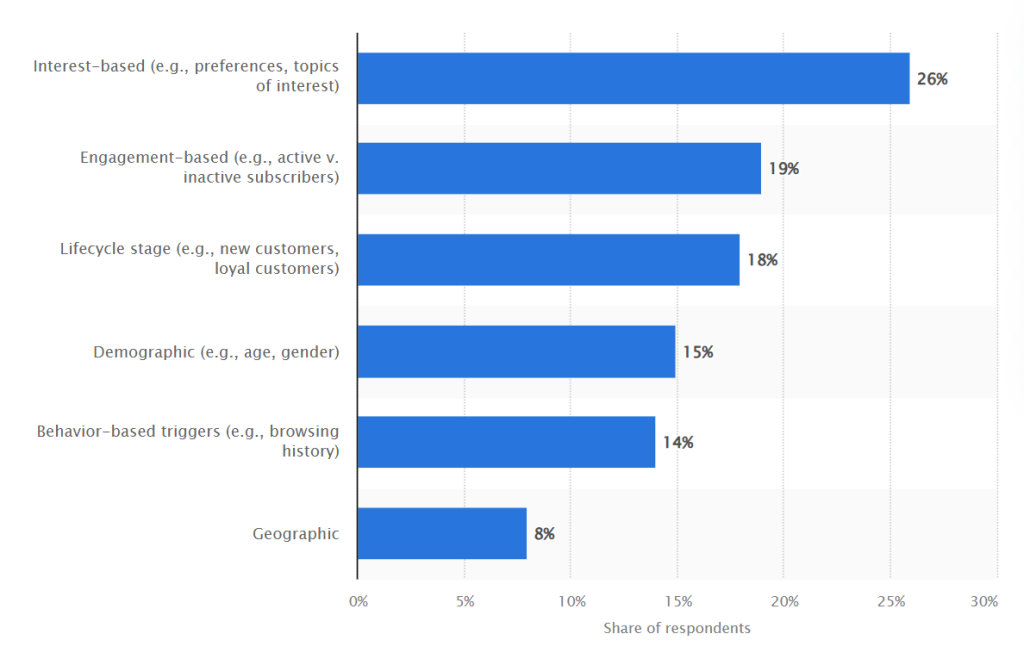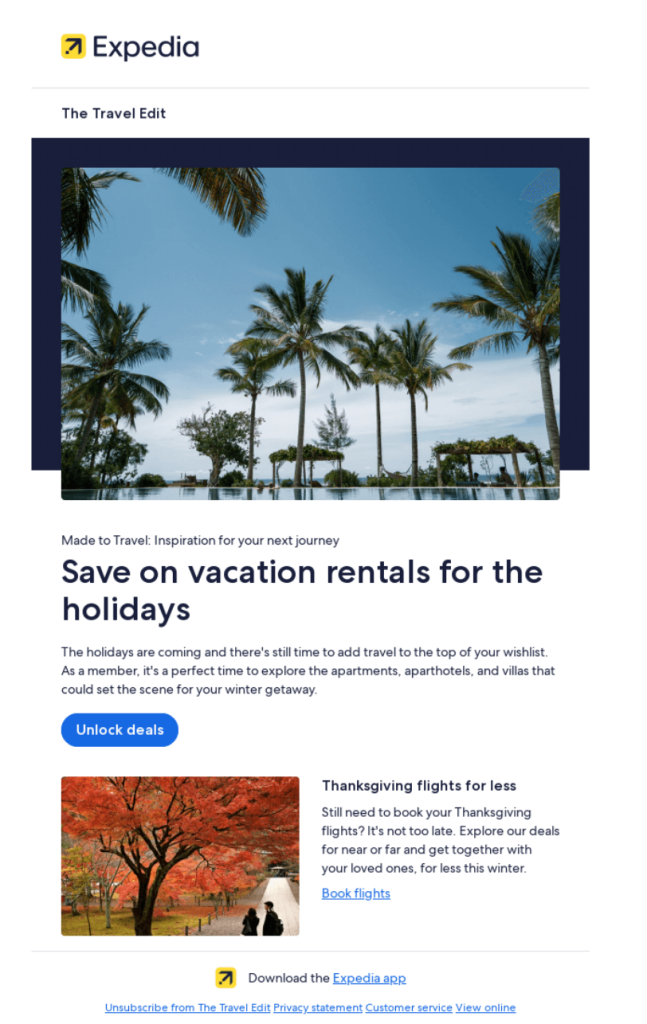- Home
- Email Templates
- Segmentation Secrets for Trave ...

It might seem like traveling is made up of a few generic components: flying, hotels, city tours, seaside resorts, and sunbathing. Nonetheless, tourism is much more nuanced than it might seem at first glance. And there are lots of different niches and segments in it: luxury retreats, family vacations, budget-friendly city breaks. In fact, there might be a tour for any type of specific interest or audience.
For travel email marketing, it means that email campaigns we make should reflect this diversity just as much. Numbers back this up. One research suggests that segmented email campaigns can deliver open rates 14.31% higher than non-segmented ones. Similarly, according to McKinsey, personalization at scale (made possible by smart segmentation) can lift conversion rates by up to 15% and boost customer satisfaction by 20%.
Travelers are not all the same, and their motivations couldn’t be more diverse. Some are chasing adrenaline, others are looking for peace and quiet, while still others want to explore the world with their kids. Segmentation allows you to match your message to each different mindset. In this article, we’re going to talk about how segmentation can help the travel industry do its best and create email campaigns that work best for different types of tourists and in different ways.
Why Segmentation Is the Secret Ingredient in Travel Email Marketing
Segmentation means dividing your email audience into smaller groups based on certain criteria (like demographics, behavior, interests, and others), so you can send more relevant content to each group. Since people tend to engage with offers that feel relevant to them personally, they will most likely ignore a generic travel offer. On the contrary, a targeted message that speaks to someone’s specific travel dreams or pain points will be noticed and appreciated.
But does it really work?
The statistics make a strong case for segmentation. As mentioned, segmented campaigns dramatically outperform generic ones in key metrics, drive significantly higher open and click-through rates, and ultimately lead to more conversions. One study found segmented emails yield about 30% more opens and 50% more clicks than unsegmented ones. With more relevant content, recipients are not only more likely to open your message but also to take action on it. Many marketers (around 78%) say that segmenting their email lists is the most effective way to improve campaign performance.
Relevance for travel industry
In travel marketing, segmentation is especially important because different travelers have vastly different motivations and preferences. If you send out one generic “summer vacation deal” email to your entire list, you’ll be competing with every other travel offer out there. What’s even more frustrating, your offer won’t be a catch for many recipients either. Especially since 53% of travel and hospitality companies use personalized emails when sending offers to their clients, which means that the importance of segmenting your customers according to their interests and tastes is a growing trend in the travel industry. Besides, by narrowing your focus, you also narrow the competition, which increases your chances for conversion.
How to make customization easy

To better understand how segmentation works in practice, let’s look at a travel email template designed specifically for Women’s Day.
The template explicitly framed the offer as being for women, with a program inspired by female experiences and stories. For example, it highlighted women-led tours, retreats shaped by wellness and reflection, and destinations with powerful women’s histories. Some of the travel offers include “Wellness Weekend in Slovenia” or “Seaside Yoga and Journaling Retreat,” aimed at either solo travelers, mother-daughter getaways, or groups of female friends.
While this message fits perfectly for women looking for a meaningful trip, it would likely fall flat for other segments—say, couples with kids or adrenaline seekers into extreme sports. And that’s the whole point of segmentation: you adjust your efforts to the audience that will truly appreciate the offer.
The good news: even if the idea of creating many versions of emails sounds daunting, modern tools have you covered. By using fully customizable and free travel email templates from Sendigram, you can design one base layout and then adjust the content for each segment. You might swap out images, headlines, or offers based on whether you’re targeting luxury travelers or backpackers, families or solo explorers. With dynamic content and template customization, you can ensure every segment gets an email that feels personal without needing to start from scratch each time.
Most effective email marketing segmentation strategies as of January 2025 (according to marketing professionals in English-speaking markets worldwide)

Core Segments Every Travel Marketer Should Know
💎 Luxury vs. budget travelers
Luxury travelers: For high-end travelers, personalization matters more than for other groups because they appreciate exclusivity above all else. Luxury travelers respond to travel email examples that make them feel like VIPs, so your campaigns to this group should emphasize unique luxury escapes and premium experiences.
If you want to capture this niche, you need to think beyond standard packages. The offers should center around private villas, first-class flights, or once-in-a-lifetime experiences that can’t simply be found in a brochure. That’s why every element of your email for luxury travelers—from the subject line to the design, the visuals, and even the microcopy—should convey sophistication, personalization, and uniqueness.
Budget travelers: When you target budget travelers, your focus has to be completely different, because this group is motivated far more by value and affordability than by prestige. For them, a travel email needs to lead to deals, discounts, and cost-saving opportunities right from the start.
Budget-conscious travelers want to feel like they’re getting lucky—as if they’ve stumbled upon a smart way to enjoy themselves without overspending. That’s why it’s important to make your messaging sound enthusiastic, friendly, and opportunity-driven. The tone should emphasize the thrill of catching a great deal, not suggest that you’re handing out some charitable offer. This approach creates its own sense of exclusivity, but in a very different way. For budget travelers, the exclusivity lies in knowing they’ve secured the best value for their money and can enjoy a full, memorable travel experience without paying premium prices.

💎 Families vs. solo travelers
Families: When addressing families, the focus should be primarily on safety, convenience, and kid-friendly features. Parents want to know their trip will be enjoyable for everyone and hassle-free to organize. A travel email to this group should highlight stress-free packages that take care of logistics and activities that keep children entertained. Subject lines such as “Stress-Free Summer Getaways for the Whole Family” will fit just right. For families, exclusivity means feeling secure, cared for, and able to enjoy quality time together, but also to avoid the stress of planning every little detail themselves. So, highlight exactly that in your email campaign.
Solo travelers: Solo travelers, on the other hand, are motivated by adventure, independence, and unique experiences. Their travel emails should emphasize freedom and discovery. The tone here should be empowering and inspirational. Encourage them to chart their own course while knowing there’s a network of experiences and people waiting for them. Exclusivity for this segment lies not in luxury or savings, but in the chance to live life on their own terms and collect stories they can’t get anywhere else.
💎 Adventure vs. relaxation seekers
Adventure seekers: For travelers driven by adrenaline, a travel email should spotlight thrilling, off-the-beaten-path experiences. These could be trekking expeditions, extreme sports, or wildlife safaris. The subject line should pulse with energy, while visuals should feature dramatic landscapes and daring activities. Try to convey the feeling of thrill through your tone and visuals—this will allow them to feel a rush of adrenaline even before they click.
Relaxation seekers: Relaxation seekers are on the opposite spectrum from adventurers—they want anything but adrenaline. This group is looking for peace, comfort, and an escape from stress on their vacation. A travel email to this audience should showcase visuals of spas, resorts, cruises, or wellness retreats, and the tone should immediately feel soothing. Subject lines like “Your Escape to Bliss Is Here” paired with imagery of hammocks and sunsets can set the mood before they even open the email. If you can plant this picture of serenity in their mind, you dramatically increase the chances they’ll click and book.
Source: Really Good Emails
💎 Frequent flyers vs. occasional vacationers
Frequent flyers: Frequent flyers are driven by efficiency and recognition, so they value loyalty programs and upgrades above all else. Promises of mileage points, VIP upgrades, or special access to lounges speak their language. To interest them, you need to remind them not only that you value their repeat business but also that you reward it in ways that matter. If you manage to show them their loyalty translates into faster, smoother, and more rewarding travel, you’ll win their clicks.
Occasional vacationers: Finally, occasional travelers see each trip as a special, often long-awaited event. So, when crafting an email campaign for them, put the accent on fulfilling dreams and storytelling. Enrich your content with visuals and make it emotionally charged. This way, you create a great deal of anticipation for this group of people, which becomes an experience for them even before the trip starts. It allows them to visualize the trip much better and makes them much more excited to click and learn more.
Source: Really Good Emails
Smart Data to Power Travel Segmentation
Great segmentation is driven by great data. To effectively segment your travel audience, you’ll want to leverage a mix of data sources that tell you who your subscribers are and what they want. Here are some of the smartest data points to use for powering your travel email segmentation:
Behavioral data: To segment based on behavior, you need to collect and analyze data on how customers interact with your product or service and then group them into segments with shared patterns. These behaviors can include purchasing habits, product usage, loyalty, or even engagement tied to specific occasions. By identifying these commonalities, you can form larger clusters of customers and direct tailored messages or travel product offers to each one.
Demographics: Classic demographics still play an important role in travel segmentation. Knowing a subscriber’s age, family status, income bracket, or other demographic info helps you predict what kind of trips might appeal to them. A young single professional in their 20s might be interested in weekend city hops or adventure tours; a retired couple in their 60s might prefer leisurely group travel or cruises.
Use demographics to guide you, but do not over-generalize—in the end, not every senior wants to be on a cruise. Combining demographic segments with other data (like interests) can refine your targeting. For instance, “young adventure travelers” vs. “young luxury travelers” might both be in their 20s but will get different emails based on budget and style.
Booking history: Booking history is another powerful guide you can use to shape more personalized campaigns. Pay attention to the types of trips your customers book—for example, ski resorts vs. seaside all-inclusive, or major city stays vs. luxury resorts. Notice whether they prefer the same destinations or experiences repeatedly, as this often suggests they are likely to do the same next season. Also track timing and patterns: if someone always books a December getaway or consistently flies with the same airline even to different destinations, that signals brand loyalty you can cater to by recommending their preferred carrier. The more details you gather from past booking history, the more personalized and exclusive your travel email offers will feel to them.
Real-time engagement: While static data is useful, real-time engagement is what keeps your segments alive and responsive. Pay attention to how your customers behave in the moment. For example, if a subscriber who is usually active suddenly hasn’t opened your last few campaigns, they may fall into a dormant segment, and you can send a special re-engagement email. Real-time data can also come from on-site behaviors, such as abandoned cart searches. If a user was in the process of booking a flight or browsing a specific tour and left, you can follow up with a targeted reminder or related offer. A well-timed travel email triggered by recent engagement—within hours or a day of the action—can significantly boost conversion chances because the destination or plan is still fresh in the subscriber’s mind.
Advanced Segmentation Ideas for Travel Marketers
While we’ve already covered the core data you can use to segment subscribers and make your travel campaigns feel personal, segmentation is never finished. There are always extra layers you can add to refine your targeting and make your emails feel even more personal.
Geo-segmentation: Use location data to promote weekend getaways to people living near a destination or send seasonal offers that match their climate (ski trips to those heading into winter, beach escapes to those in colder months). You can also segment by home airport, showing only trips that are convenient from their city.
Interest-based segmentation: Collect data on passions—food, wellness, history, adventure—and shape itineraries accordingly. A foodie might get emails about vineyard tours or street food festivals, while wellness seekers see yoga retreats or spa resorts. Adding interest tags in your signup forms makes this easy to scale.
Below you can find an example of an interest-based travel email template. Being packed with diverse info about the routes and trip schedules, as well as tips for recommended bikes and clothing, this template , nonetheless, targets a very particular type of tourist.

Trip stage segmentation: Adapt content to where the traveler is in the funnel: send inspiration to dreamers, price comparisons to planners, urgency-driven offers to bookers, and surveys or loyalty perks to post-trip customers. Triggered emails based on browsing or booking behavior work especially well here.
To Sum Up
The travel industry thrives on making people’s dreams come true, and with smart segmentation, your email marketing can do the same by delivering the right dream to the right person.
While implementing these segmentation ideas will require some initial effort in organizing your lists and content, higher open rates and increased conversions—not to mention happier customers—will be totally worth it.
So, take the time to know your audience and tailor your approach. Your next segmented travel email campaign might just become your most successful one yet.
Bon voyage on your email marketing journey!



